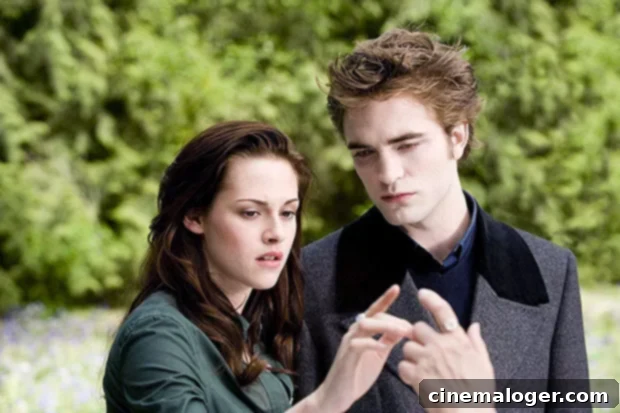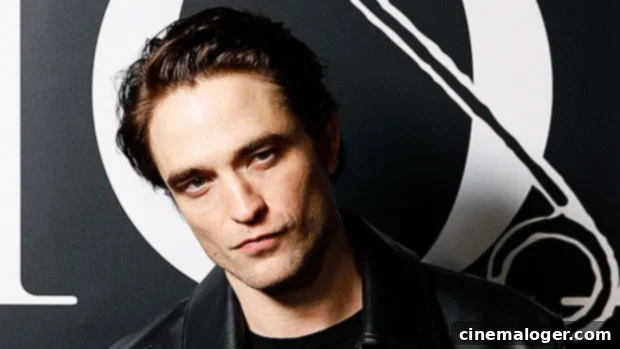Robert Pattinson’s Enduring Scar: Navigating Stardom, Paparazzi Trauma, and the Quest for Privacy
For many, the mention of Robert Pattinson immediately conjures images of the brooding vampire Edward Cullen from the wildly successful Twilight saga. Yet, behind the glittering veneer of Hollywood stardom, Pattinson harbors a deep-seated trauma, a direct consequence of the relentless paparazzi pursuit he endured during his ascent to global fame. In a recent interview, the celebrated actor confessed that the years of living under a microscope have left an indelible mark, compelling him to continue dodging cameras even today. His story serves as a poignant reminder of the often-overlooked psychological toll that intense media scrutiny can take on those thrust into the unforgiving glare of the public eye.
The Lingering Shadows of Stardom: Robert Pattinson’s Paparazzi Ordeal
It has been eight years since the final installment of the Twilight series captivated audiences worldwide, but for Robert Pattinson, the memories of that era are far from nostalgic. Instead, they are punctuated by what he describes as “terror memories” of the paparazzi. The actor, now 37, shared with GQ that he still instinctively dons “full-on protective armor — hood up, hat down” whenever he ventures out in public. This isn’t merely a fashion statement; it’s a deeply ingrained defense mechanism born from years of feeling hunted.
During his Twilight heyday, Pattinson’s life was a constant spectacle. The level of global obsession with the movies and their stars was unprecedented, transforming him overnight from a relatively unknown actor into a worldwide sensation. With this meteoric rise came an unwelcome shadow: the incessant, aggressive pursuit by photographers. He famously recounted instances of riding in car trunks or adopting elaborate disguises, all in a desperate bid to reclaim a sliver of normalcy and privacy. The sheer intensity of this period meant he could rarely leave his home without being hounded, every movement documented, every expression scrutinized. This relentless surveillance created an environment of constant vigilance, fostering a deep sense of unease and vulnerability that continues to affect him.
Even though the fervor has significantly subsided compared to the peak of Twilight mania, the precautions he was compelled to adopt have become second nature. It highlights how profoundly such experiences can shape an individual’s perception of public space and personal safety. The trauma isn’t just about the physical intrusion; it’s about the psychological burden of feeling constantly exposed, losing control over one’s own image, and the erosion of personal boundaries. For Pattinson, the “protective armor” isn’t just against cameras; it’s a shield against the lingering psychological echoes of a period when his life felt anything but his own.
Twilight’s Double-Edged Sword: Fame, Love, and Media Scrutiny
The challenges faced by Robert Pattinson were undeniably amplified by the unique circumstances of his role and personal life. As Edward Cullen, he became the ultimate romantic idol, the subject of fervent fan adoration across the globe. This fictional romance spilled over into reality when he began dating his onscreen love interest, Kristen Stewart, who portrayed Bella Swan. Their real-life relationship became a global phenomenon, captivating millions of Twilight fans and media outlets alike. This convergence of intense fictional devotion and genuine personal connection created an unparalleled media frenzy that few celebrities have ever experienced.
The public’s obsession with their relationship meant that every date, every public appearance, every rumored disagreement became front-page news. There was no escaping the speculation, the analysis, or the often-invasive commentary on their private lives. For two young actors, barely out of their teens and thrust into such a blinding spotlight, navigating a relationship under such intense scrutiny was an immense challenge. The pressure to maintain a perfect public image, combined with the constant threat of paparazzi intrusions, undoubtedly placed enormous strain on their personal lives. Their privacy was virtually non-existent, and their relationship became as much a public spectacle as the movies themselves. This intense period of shared experience, however tumultuous, forged a unique and enduring bond between them.
A Shared Bond: Robert Pattinson and Kristen Stewart’s Enduring Connection
Despite their romantic relationship ending six years ago, the profound experience they shared has created a lasting connection between Robert Pattinson and Kristen Stewart. A source close to Robert exclusively told HollywoodLife that “Robert and Kristen talk from time to time,” indicating a continued, amicable relationship. The insider further elaborated, stating, “They still support each other because they are genuine friends. They both went through something with Twilight that most people never even deal with. They grew up in Hollywood together, and what they dealt with created a deep bond.”
This “deep bond” stems from a shared understanding of a highly unusual and intensely challenging period in their lives. Very few people can truly comprehend what it’s like to experience global adoration, intense media scrutiny, and the erosion of personal privacy at such a young age. Having navigated that tumultuous journey side-by-side, Pattinson and Stewart forged a unique solidarity. They understand the psychological pressures, the bizarre nature of their fame, and the lingering effects it has had on their lives and careers. This mutual empathy transcends their past romantic involvement, forming a foundation of respect and genuine friendship. Their ability to remain friends speaks volumes about their maturity and the unique, almost familial connection born from surviving an extraordinary period together, an experience that forever linked them in the annals of pop culture history.

Beyond the Vampire: Robert Pattinson’s Career Evolution and The Batman
Following his time as Edward Cullen, Robert Pattinson made a deliberate and often acclaimed pivot in his career. He consciously sought out independent films and challenging, unconventional roles, aiming to shed the teen heartthrob image and establish himself as a serious dramatic actor. Films like Good Time, The Lighthouse, and High Life showcased his versatility and willingness to delve into complex characters, earning him critical praise and solidifying his reputation beyond the blockbuster franchise that made him famous. This period allowed him to hone his craft away from the intense commercial pressure, developing a more nuanced and introspective approach to acting.
His upcoming role as the Caped Crusader in The Batman marks a significant return to the realm of major tentpole productions. However, this return is different. Pattinson approaches this iconic role with greater maturity, artistic intent, and the wisdom gained from his past experiences. The decision to take on Batman, a character steeped in cultural legacy and enormous fan expectations, speaks to his evolving confidence as an actor and his desire to re-engage with a large audience on his own terms. He’s no longer the naive young actor caught in a media storm; he’s a seasoned professional making calculated choices. This role offers him an opportunity to define one of pop culture’s most enduring figures, while also navigating the renewed surge of public interest that inevitably accompanies such a high-profile project, armed with a greater understanding of the fame machine.
Fashion as Expression: From Disguise to Aspiration
In his interview with GQ, Robert Pattinson touched upon another facet of his public persona: his style. While he currently relies on practical attire—hoods and hats—as a protective measure against unwanted attention, he expressed a desire for greater sartorial freedom. “I wish I could dress like A$AP Rocky, he just has serious style,” The Lighthouse star admitted. Pattinson recounted being in fittings with the rapper, witnessing Rocky effortlessly pull off outlandish garments that Pattinson felt he “would look like a total moron” in. Yet, Rocky would wear them to a show and “literally wear anything!”
This anecdote highlights a fascinating dichotomy. On one hand, Pattinson’s public appearance is dictated by his need for anonymity and protection, forcing him into a conservative, almost camouflaged style. On the other, there’s a longing for bold, uninhibited self-expression through fashion, inspired by figures like A$AP Rocky who exude confidence and individuality. Pattinson has, in recent years, also become a prominent face for Dior Homme, which allows him to experiment with high fashion within controlled environments like red carpets and ad campaigns. This role offers a creative outlet, a space where he can explore his aesthetic sensibilities without the immediate threat of intrusive cameras. It’s a journey from using clothing as a shield to aspiring to use it as a powerful, personal statement, revealing a desire to reclaim public identity on his own terms.
The Evolving Landscape of Celebrity Privacy in the Digital Age
Robert Pattinson’s ongoing struggle with paparazzi attention offers a valuable lens through which to examine the broader challenges of celebrity privacy in the modern era. While traditional paparazzi still exist, the landscape has evolved significantly with the advent of social media and ubiquitous camera phones. Every fan can now become an impromptu paparazzo, blurring the lines between professional intrusion and casual observation. This shift means that public figures face an unprecedented level of constant surveillance, where every meal, every walk, and every private moment can potentially be captured and shared instantly across global platforms.
The psychological toll of living under such intense, perpetual scrutiny is immense. It can lead to chronic anxiety, paranoia, a pervasive feeling of not being safe or truly private, and even impact mental health. Celebrities often feel a profound loss of control over their own narratives and personal lives, constantly having to manage public perception in a world where information spreads like wildfire. Pattinson’s enduring “terror memories” serve as a potent example of how deeply these experiences can scar an individual, transforming mundane activities into exercises in evasion and self-preservation. His story underscores the ongoing debate about the boundaries of public interest versus personal privacy and the human cost of relentless celebrity culture.
In conclusion, Robert Pattinson’s journey from Twilight sensation to acclaimed actor is a testament to his resilience and talent, yet it’s also a compelling narrative about the profound, lasting impact of extreme fame. His continued efforts to maintain privacy, his candid reflections on the past, and his evolution as an artist all paint a picture of an individual navigating the complex demands of Hollywood while striving to protect his inner self. As he takes on new challenges, like embodying The Batman, Pattinson continues to forge his path, forever marked by his past, but resolutely focused on a future where he can express himself, both on and off screen, with authenticity and a hard-won sense of self-possession.
